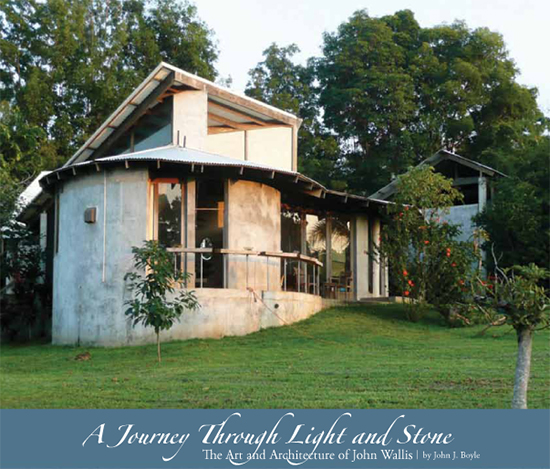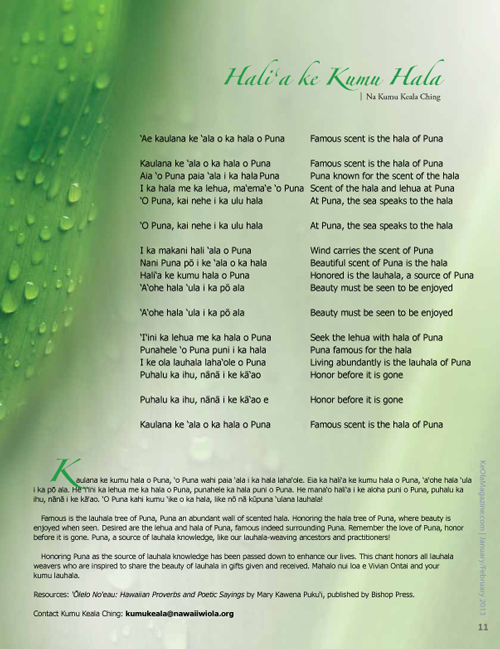
A Journey Through Light and Stone: The Art and Architecture of John Wallis
By John J. Boyle
A Place to Breathe in the Light
The art of creating a space for a place to live suggests an attention to placement, form, and strength of materials. In designing for Hawai‘i, engineering and traditional construction meet a sculptor’s eye and soft, human skin.
Traditional Polynesian Hawaiians built high-walled woven shelters on carefully fitted stone foundations. On the floors, woven lauhala mats were piled up for comfort on the warm stones. The windowless, hive-like shelters were cooler in the midday heat. These sleeping spaces had a high ceiling of braided fronds. The moisture that collected on the leaf roof acted like a swamp cooler as the air passed through it. A small entryway was just large enough to crawl through. They moved seasonally and the fronds were easily replaced. This kind of partially-outdoor living changed with increasing contact with world cultures that brought mosquitos, vermin, disease, and a rectitude that rejected their organically breathing hut structures.
John Wallis, an architect for more than fifty years, sees to how we live in houses and why. His forms embody a practicality which some call Sacred Geometry, Sustainable Design, or Feng Shui. Yet for John, his design choices are a matter of distinct practical efficacy.
In his solutions for building in Hawai‘i he uses locally produced concrete and sustainably harvested woods. He comes up with site-specific solutions for living with the land as opposed to on it, and caring for—rather than exploiting—the ‘āina. In this, he is very much of his time and of this place.
For John, Feng Shui is a wisdom that has to do with the nature of the building and sacred geometry has to do with the structure. Both express practical and aesthetic choices, which can include pathos, spirituality, and healing energies. Intuitively, rather than formally trained and experienced, John may not be able to define his work in terms of fractals or a golden ratio, but he may comment that, “it works.” One may explain the beauty of an enclosed setting as defined by a Chinese elemental system, or perhaps it just makes sense. Although John’s work may seem new, it is merely a return to practical efficient design.
Having designed and built in climates with four, two, and seemingly one season, he is well informed. His travel, patience, and curiosity prepared him for building in Hawai‘i. On a small avocado orchard 270 feet above sea level in North Kohala he has built his own home where he lets in light, cohabiting with the land. He named his home Nalukea, the Hawaiian word for ‘white wave’, after an image of pāhoehoe lava that gleamed in circular, silver waves.
Rare the Few Who Land Here
For those who have the resources and good fortune to build their own home where they want to, the art of architecture exists.
Out of this practice innovation and excellence speak of all time. In most cases, the way it is done goes unquestioned—houses are built and homeowners become homemakers by what they bring into it. Building codes are in place to protect an owner and builder from foreseen errors. At other times, codes and regulations challenge creativity. In John Wallis’ architecture innovation combines with nuance, inviting the natural beauty indoors. His tropical gardens are only a breath away, thinly distanced by glass and screens.
The ability to sense a form in a place before it exists demands attention to the lay of the land and the coursing of weather. Hawai‘i’s climate may appear to be benign, or even static in its consistently comfortable temperature range. One is more inclined to be outdoors with the elements in such a temperate clime. John’s designs reflect traditional and state of the art stone work of Greek, Caribbean, Mexican, and Southeast Asian styles, in effect, holistic sensibilities. Hawai‘i’s temperate position in the unobstructed ocean is at the same latitude as other more humid continental communities. It is fair to model after such places, yet there is a need to note our distinctions. Hawai‘i is different because the trade winds cool and aerate each of our 11 out of 13 distinct micro climates. Thus his screens and walls are carefully placed.
Salt, seeds, and pollen make good with our trade winds. In turn, on up the food chain, from hundreds of molds and microbes to the ants, spiders, lizards, and rodents, each subsequent ground feeder is the food of another. It is the work of informed design to attend this fact of nature.
On John’s home an external traffic lane of a concrete apron walkway embraces the house, next to that is a skirt of thin gravel. The poured concrete slab on which the walls stand is thicker and deeper then ordinary floors or footers. This slightly thicker concrete acts as a thermal battery storing the day’s ambient heat and warmly radiates into the evening balancing day and night temperature changes. This warm concrete barrier moat also dissuades molds and offers few cool corners for insects. Understandably, what works for human comfort suits many other life forms and so his conscious design manages pests without toxic poisons.
Out of the Box
A world accustomed to boxes has created a product line of materials and codes as well as a business of selling and manufacturing parts. John has, in a sense, outgrown the exclusive use for rectangular building. Upon buying his land in 1999, John lived in a tent and began his stewardship while he honed in on where and how his house needed to be set. He began drawing and sketching before he landed on his design.
The journey from pencil to shovel was as rife with glorious incidents as it was with impediments and challenges. From the pitch of the roof to the placement of openings, his house was designed to meet and embrace the subtle seasonal weathers. His house is a one-story, many-leveled, open-floor design that makes for ease of stride.
Twenty-seven poured concrete cylinders are set at angles to support the leaf-shaped umbrella roof.
The interior spaces are defined by glass or screens and shade cloth is used to create 20-foot tall walls. The high, enclosed spaces are set into the roll of a hillside. Not one of the six glass openings vies as the front door, nor does it seem to matter, as they all serve equally as access-ways.
“It is like a tree, with no facade front or back, per se.”
The Concept
“It is mostly in the concept, the details are to refine. If you have a really strong concept, the details are there to support it.”
A concept can be a style of indoor versus outdoor living, or to integrate the natural with the manmade. Or it could be building out of one’s immediate environment and a detail could be which materials and why.
“How do you belong or respond?” he asks. “What are the joys and the pleasures of the relationships to the natural and man made? I really like the way they work together.”
Another concept is the budget. How much per square foot as opposed to an unlimited budget?
“There is nothing to refine without a concept. It could consist of using red, yellow, white, and copper alongside natural woods. A limited palate can give a dynamic impression.”
“A building needs a sense of center. Where are people going to end up when they enter? What is the next order of events? What is the journey?”
The unifying quality of the design for his home is derived from sections of cylinders and angles. Even the hinges on the doors are little cylinders. Like leaves in the orchard, the circular and angular forms relate to each other. A simple round catchment for his orchard reflects the summer moon and casts light upon contiguous spaces.
On a more practical level, John’s structures consider North Kohala winds. One of the ways the building breathes is through the air space or cracks around an opening or a door, they are not sealed and yet are thin enough to deflect the zigzagging earthbound mosquitos and flies. In some other similar mosquito climates, homes are built high off of the ground, above the bug zone. Mosquitos tend to swarm around slippers and shoes because they sense human essences, so shoes are kept a short walk away from the door. By reducing access and providing sunlight, other life forms are disinvited into a home’s comfort. John has created ventilated cabinets with drawers that breathe. This is done by using galvanized half inch wire grid bottoms. This shelving is too precarious for cockroaches and manages to keep the neighborhood insects apart from household activity.
The library’s wall of books is set to meet the winter’s sunlight against an eastern thermal wall, defending against moist tropical air and darkness which tends to mold paper.
Efficiently, one dimmable 200-watt light fixture in the center of his round living room illuminates each of the exterior accesses.
Bird Cloud, The Delight of Beauty
In Annie Proulx’s nonfiction book about building her home Bird Cloud, she writes: “The Agustan architect Marcus Vitruvius Pollio is regarded today more as a figurehead father of architecture than someone whose views on houses belong in the pages of Dwell or Wallpaper, but there is something terribly obvious about his three general precepts in De Architectura that have held true over two thousand years: that an architect-designed building must have integrity of structure, a responsibility to function, and the added delight of beauty. Included in these precepts might be enhanced landscaping, and, as we discover today, in the first years of the third millennium, the necessity of making energy-efficient, water thrifty houses overrides everything else. Buildings must operate within stricter “green” bounds.”
John Wallis’s concrete construction is sustainable, cost efficient, and environmentally sensible as our wood stock diminishes into the past. His simple design obviates the expense of drywall, trim, caulking, and paints. By estimates of square footage under the roof, his costs are half of that of a more traditional construction.
The Journey
Walking the land is the beginning of what John calls the journey of collaboration. He says, “If I fail in a building, I fail to keep that journey going.”
On another of his building sites in the Kohala Mountains, John explains a work in progress, “See how it is triangulated among these lava-slump-angled hills. These angles are also the earth’s angles. That’s where the house gets its geometry, from the slump in the lava.” In another use of the word, John describes how triangulation in construction makes a building stronger and there is less construction waste and less stiffening energy to build a typical rectangular unstable form. It is more efficient and aesthetic as it allows for a larger range of organic shapes.
The Hawaiians with their A-frames were working with a similar understanding.
As we walk on the land he says, “Working while the sun provides the necessary light is a very green and natural act.”
“As an arch builder, through these amazing years, I have been part of the process that has enabled an Arabian horse ranching couple to have their poetry; a Hollywood Director ‘a triple Wow’; a UCLA Professor, his ‘Greek house with a Blue Roof’; and today a client sits in his ‘Bird of Prey,’ settling down upon the western slopes of the Kohala Mountains. All of these are site-specific, live-in-sculptures, as unlike another as they honor our sentient human condition with an unrelenting objective that differentiates and allows each owner’s personal expression formed in stone, space, and light.”
Resources:
A Memoir of Place Bird Cloud by Annie Proulx, 2011, p121.
Creating Sacred Space With Feng Shui by Karen Kingston, 1997.
Contact John Willis: 808.889.5790
Contact writer John J. Boyle: jjjboyle2112 AT gmail DOT com


